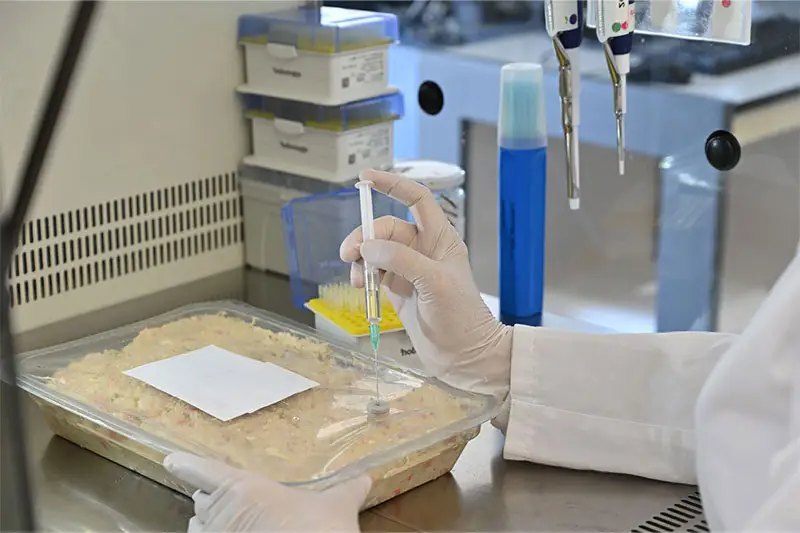Biofilm Formation Testing in Cosmetic Manufacturing Equipment
The presence of biofilms within cosmetic manufacturing equipment can lead to contamination and degradation of product quality. Biofilms are complex communities of microorganisms that adhere to surfaces, often forming a protective layer that resists conventional cleaning methods and chemical disinfectants. In the cosmetics industry, biofilm formation in manufacturing equipment poses significant risks as it can harbor pathogens such as Candida albicans, Staphylococcus aureus, and other opportunistic microorganisms.
Biofilms are particularly problematic because they are not easily removed by standard cleaning procedures. This is why biofilm formation testing in cosmetic manufacturing equipment is critical for ensuring the safety, quality, and shelf-life of cosmetics. The testing process typically involves inoculating a sample surface with a known microbial strain or mixture, incubating it under conditions that favor biofilm development, and then assessing the extent of biofilm growth.
Testing methods may include visualization techniques such as scanning electron microscopy (SEM) or confocal laser scanning microscopy (CLSM). Quantitative measures can be obtained using crystal violet staining, which adheres to the biofilm matrix, allowing for quantification through spectrophotometric readings. Another method is the use of microbial biomass assays that measure total cell content within the biofilm.
The acceptance criteria for a successful test are typically set according to international standards such as ISO 22516-4:2017, which provides guidelines on how to evaluate biofilm formation on surfaces. Compliance with these standards ensures that the testing methodology is robust and reliable, thereby enhancing confidence in the safety of cosmetic products.
The importance of this test cannot be overstated given its role in preventing contamination issues that could lead to product recalls or even health hazards for consumers. By implementing rigorous biofilm formation testing protocols early in the manufacturing process, companies can identify potential problems before they become critical issues downstream in production. This proactive approach not only protects consumer safety but also enhances brand reputation and compliance with regulatory requirements.
For quality managers, compliance officers, R&D engineers, and procurement teams involved in cosmetic product development and manufacturing, understanding the nuances of biofilm formation testing is essential. It allows for better decision-making regarding equipment selection, maintenance schedules, and process optimization aimed at minimizing biofilm risks. Properly conducted tests can help ensure that all aspects of the production environment meet regulatory expectations, thus safeguarding both end-users and manufacturers.
Benefits
The benefits of conducting biofilm formation testing in cosmetic manufacturing equipment extend beyond mere compliance with regulations. By identifying and addressing biofilm issues early on, companies can significantly reduce the risk of contamination incidents that could lead to costly product recalls or lawsuits. Additionally, maintaining a clean environment reduces operational costs associated with frequent cleaning and sanitization efforts.
From an environmental perspective, minimizing microbial loads helps preserve natural resources by reducing unnecessary chemical use during disinfection processes. Furthermore, ensuring consistent quality across batches supports sustainable practices within the industry. For R&D engineers specifically, this testing ensures that new formulations do not inadvertently contribute to biofilm formation, which could compromise product integrity.
Compliance officers will appreciate how thorough biofilm testing demonstrates commitment to regulatory adherence and consumer protection. It also provides valuable data for continuous improvement initiatives aimed at enhancing overall hygiene standards within manufacturing facilities. For procurement teams, selecting suppliers who prioritize these types of tests ensures access to high-quality materials and equipment that support long-term reliability.
Why Choose This Test
Selecting biofilm formation testing for cosmetic manufacturing equipment is crucial due to its ability to address several critical challenges faced by the industry. Firstly, it provides a comprehensive assessment of the effectiveness of current cleaning and sanitation protocols. Secondly, it offers insights into potential hotspots where biofilms may form based on specific process parameters or machinery design features.
For those looking to innovate within their operations, this test serves as an essential tool for developing more hygienic manufacturing practices. By identifying weak points in the production line through biofilm testing, companies can implement targeted interventions that enhance overall hygiene levels while reducing resource consumption. This not only improves product quality but also contributes positively towards sustainable business models.
The availability of advanced analytical techniques such as real-time PCR and next-generation sequencing adds another layer of depth to understanding biofilms' composition and behavior. These technologies allow for precise quantification and characterization, providing deeper insights into microbial communities present in different parts of the equipment.
Environmental and Sustainability Contributions
Biofilm formation testing plays a vital role in promoting environmental sustainability within the cosmetics industry by fostering practices that reduce waste generation, energy consumption, and chemical usage. By minimizing microbial contamination at each stage of production, companies can adopt more sustainable approaches to manufacturing while enhancing product quality.
The identification and control of biofilms contribute directly to resource conservation efforts. Through better hygiene management, less water is wasted during cleaning processes since targeted interventions are applied only where needed rather than blanket treatments across entire facilities. Similarly, fewer chemicals are required for disinfection purposes as these can now be concentrated on specific areas prone to biofilm development.
In addition to operational efficiencies gained from cleaner equipment, there are broader ecological benefits associated with reduced microbial load in wastewater discharged from manufacturing plants. This helps protect local ecosystems by preventing the spread of resistant strains that might otherwise enter natural environments via effluent streams.
For companies committed to environmental stewardship, incorporating biofilm formation testing into their quality assurance programs demonstrates leadership in responsible resource management and pollution prevention. It aligns with global trends towards circular economies where waste is minimized or repurposed into valuable products.





